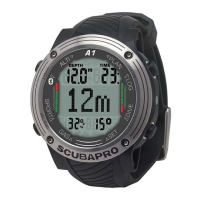46
A1 USER MANUAL
4.8 PDIS (Prole Dependent
Intermediate Stop)
4.8.1 Introduction to PDIS
The main purpose of a dive computer is to
track your nitrogen uptake and recommend
a safe ascent procedure. Diving within the
so-called no-stop limits means that at the
end of the dive you can ascend directly to
the surface, albeit at a safe ascent rate,
while for dives outside of the no-stop limit
(so-called decompression dives), you must
perform stops at certain depths and allow
time for excess nitrogen to be expelled
from your body before nishing the dive
and re-surfacing.
In both cases, it can be benecial to stop
for a few minutes at an intermediate depth
between the maximum attained depth
during the dive and the surface or, in case
of a decompression dive, the rst (deepest)
decompression stop.
An intermediate stop of this kind is benecial
as soon as the ambient pressure at that
depth is low enough to ensure that your
body is predominantly off-gassing nitrogen,
even if under a very small pressure gradient.
In such a situation, you can still cruise along
the reef and enjoy the dive while your body
gets a chance to slowly release nitrogen.
In recent times, so-called “deep” stops
have been introduced in some dive
computers and tables, dened as half
the distance from the dive’s maximum
depth and the surface (or the lowest
decompression stop). Spending 2 or 15
minutes at 30m/100ft would result in the
same deep stop at 15m/50ft.
With PDIS, as the name suggests, the A1
interprets your dive prole and suggests
an intermediate stop that is a function of
your nitrogen uptake so far. The PDI stop
will therefore change over the course of the
dive to reect the continuously changing
situation in your body. Along the same lines,
PDIS will account for the accumulated
nitrogen from previous dives; hence,
PDIS is also repetitive-dive dependent.
Conventional deep stops completely ignore
these facts.
The following gure quanties the extent
of PDIS and illustrates its dependence on
cumulative nitrogen uptake for 2 sample
dive proles. This gure also demonstrates
the conceptual difference between PDIS
and the rather rudimentary “deep” stops.
Specically, the gure compares 2 dive
proles to a maximum depth of 40m/132ft
that are otherwise very different.
Prole 1 stays at 40m/132ft for 7 minutes,
then ascends to 30m/100ft for 3 minutes,
followed by 12 minutes at 20m/65ft. Prole
2 stays less than 2 minutes at 40m/132ft,
then ascends to 21m/69ft and stays
there for 33 minutes. Both dive proles
are no-stop dives to the limit of entering
decompression.
The solid line represents the PDIS depth as
displayed on the computer screen during
the course of the dive for prole 1, the
broken line represents the PDIS depth as
displayed on the computer screen during
the course of prole 2. One can see that the
displayed PDIS depth increases as more
nitrogen is accumulated in the body, but
does so very differently in the 2 dives due
to the different exposure in the 2 proles.
The PDI stop is carried out at 25 minutes
for prole 1 and at 37 minutes for prole 2,
followed by the safety stop at 5m/15ft.
The line made up of small solid dots, on
the other hand, represents the depth that
would be displayed by a computer following
the conventional deep stop method, and it
would be the same for the 2 dive proles.
Deep stops completely ignore any facts
about the dives themselves aside from max
depth.

